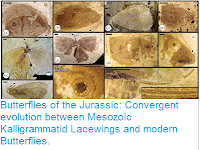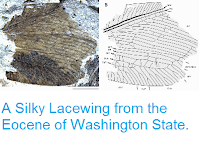The Dustrywings, Coniopterygidae, are small (usually under 5 mm) Insects
related to Lacewings and Ant-lions. They are numerous and widespread,
being found in woodland all over the world, where they feed on small
Arthropods, such as Mites, Aphids and Scale Insects, living on trees and shrubs. Largely because of their affinity
for woodland and small size, they have an excellent fossil record,
with the group appearing in the Late Jurassic and specimens preserved in amber being found across much of the globe
from the Cretaceous onwards.
In a paper published in the journal Zoological Systematics in July 2017, Xingyue Liu and Xiumei Lu of the Department of Entomology at the China Agricultural University, describe a new species of Dustywing from Middle Cretaceous Burmese Amber.
Middle Cretaceous ‘Burmese Amber’ has been extensively worked at several
sites across northern Myanmar (though mostly in Kachin State) in the
last 20 years. The amber is fairly clear, and often found in large
chunks, providing an exceptional window into the Middle Cretaceous
Insect fauna. This amber is thought to have started out as the resin of a
Coniferous Tree, possibly a Cypress or an Araucaria, growing in a moist
tropical forest. This amber has been dated to between 105 and 95
million years old, based upon pollen inclusions, and to about 98.8
million years by uranium/lead dating of ash inclusions in the amber.
The new species is named Cretaconiopteryx grandis, where 'Cretaconiopteryx' is a combinaion of 'Cretaceous' and 'Coniopteryx', the modern genus that gives the group its name, and 'grandis' means 'large'. The species is described from a single female specimen, large for a Dustywing at 5.47 mm in length with 6.67 mm forewings and slender legs with numerous hairs. The venation of the wing is sufficiently different to all other known Dustywings that it is placed in a new subfamily all of its own, the Cretaconiopteryginae, thought to have branched off from a stem lineage before the common ancestor of all other known species.
Cretaconiopteryx grandis, female specimen in dorsal view. Liu & Lu (2017).
See also...
Follow Sciency Thoughts on Facebook.







